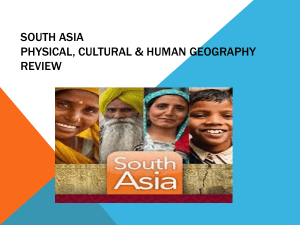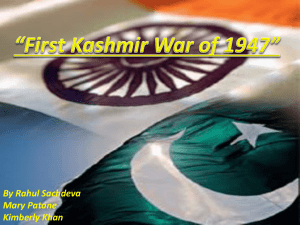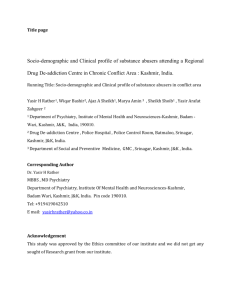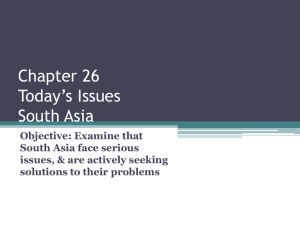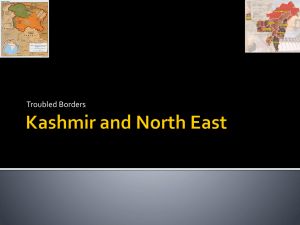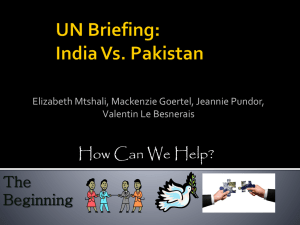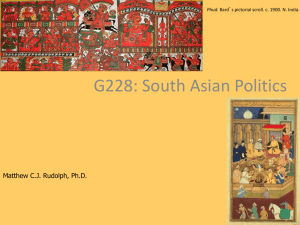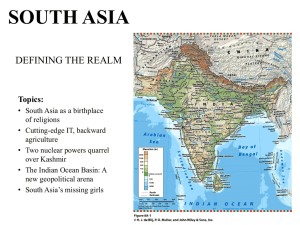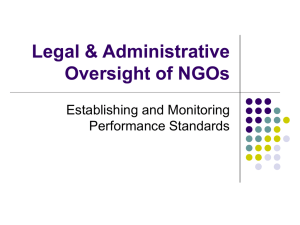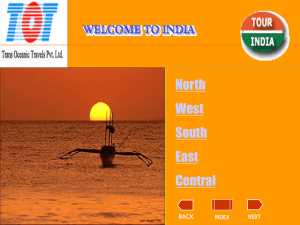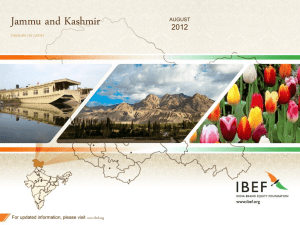the_kashmir_conundrum_new
advertisement
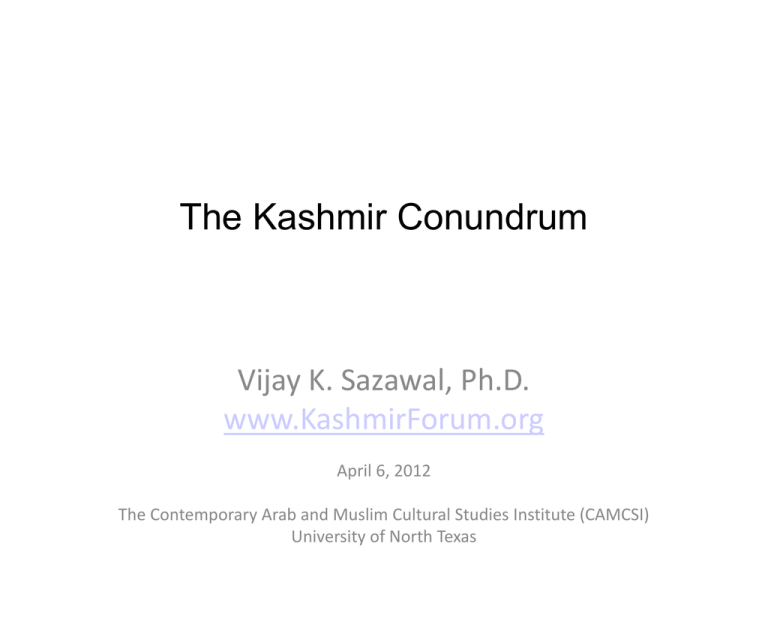
The Kashmir Conundrum Vijay K. Sazawal, Ph.D. www.KashmirForum.org April 6, 2012 The Contemporary Arab and Muslim Cultural Studies Institute (CAMCSI) University of North Texas Reflections From Recent Visits The Dysfunctional State Genesis of Corruption Functioning of the Civil Society Local Intellectual Discourse The Silent Cultural Turmoil The Triangle of Misery Concluding Remarks Page 2 The Dysfunctional State Similarities exist between J&K and failed Sub-Saharan states of Africa which have acquired tags like “corruptocracies”, or “chaosocracies” Public loyalty is almost evenly divided among politicians - elected, rejected, separatists and militants Controlling the state machinery and acquiring unfettered possession of public funds have become primary purposes of political contestation The politics is increasingly patrimonial and spoils-oriented There is a continuing contest for political and economic domination between elites, politicians, and separatists (armed and unarmed) The State is unable to provide basic services and security Consequently, J&K is experiencing a “triple crisis of governance”: Lack of accountability Lack of the rule of law Inability to resolve economic crisis Srinagar city has 91,110 stray dogs, based on a census taken in late 2011. They are a serious risk to health and safety, but no one has a clue how to deal with it Page 3 Audits of J&K by the Comptroller and Auditor General of India (CAG) CAG is the Indian equivalent of the U.S. Government Accountability Office (GAO) All publicly funded institutions in J&K – various ministries, state-run industrial units, and universities come under audit jurisdiction of the CAG Nearly all entities – except for the J&K Bank - have failed to follow professional accounting practices. Nearly 90% of the entities have failed to complete internal audits for the last 15 years through successive governments. In most cases, there is an incomplete record of why and how various expenditures were incurred The losses by the public sector units (PSU’s) runs into hundreds of millions of USD. The CAG attributes these losses to deficiencies - in financial management, planning, implementation of programs and projects, and running of operations and monitoring Perhaps the saddest part is J&K Government’s indifference towards infants and children – maternity health care, primary education, and child development schemes run by the Department of Social Welfare, which are in utter shambles The CAG Audit reports are prepared annually, tabled in the J&K Legislative Assembly and the J&K Legislative Council – and never discussed in parliamentary chambers Page 4 The Fall-Out India Corruption Study (2005), conducted by the Transparency International (TI), covered 11 public services – police (crime/traffic), lower-tier judiciary, land administration, municipal services, hospitals, electricity supply, water supply, primary and secondary education, personal income tax, public distribution system (rationed supplies), and farm credit TI ranked Kashmir as the second most corrupt state in India. Limiting analysis to urban areas in each state, the corruption ranking of Jammu & Kashmir rose to the top TI conducted another India corruption study in 2008 with special focus on bribes paid by the below-thepoverty (BPL) households. It ranked Kashmir at number 3, but found Kashmir “alarmingly corrupt” in PDS, electricity and water supply Electricity supply is a political issue in J&K because many hydro-electric projects have been commissioned by the National Hydroelectric Power Corporation (NHPC) in the State but the power supply is intermittent. Not mentioned: Transmission and Distribution losses are significant (around 62%) Power Development Department (PDD) lags in installing consumer meters Recovery of power tariff from consumers is dismally low PDD has failed to open a letter of credit with the Northern Grid, and in fact defaulted on payments 19 times in 2011-12 Page 5 Genesis of Corruption Corruption in India is driven mostly by mismanagement of regional natural resources In Kashmir, the biggest driver is addiction to the “other opium” called the OPM Page 6 J&K Main Budget 2012-2013 Total Expenditure: Rs. 33853 Crores ($7.1 billion USD) Where it goes … Salaries and Pensions: 46% Capital Expenditure (job and asset creation): 26% Power consumption: 9% Interest payment on loans: 8% Security (law and order) expenditure: 2% Miscellaneous: 9% Page 7 How is the State Budget Funded? Rs. 33853 Crores ($7.1 billion) 2012-2013 Budget (Estimate) State Revenue Receipts (i.e. taxes, rents, etc.): 22% Share of federal tax revenue provided to J&K: 13% Borrowings from the RBI and financial markets : 12% Outright federal grants: 53% State basically operates on “other people’s money” Page 8 Functioning of the Civil Society Kashmir lacks a culture of volunteerism or community managed human development programs (exception being the work undertaken by religious trusts) The first NGO’s appeared in Kashmir after the 1989 following dramatic increase in violence While some NGO’s have evolved organically, most have dubious origins. The mere fact that an NGO is officially registered does not assure its quality or integrity A select few NGO’s are active in managing orphanages, widow care, medical care, rural development, children with special needs, concerns for physically challenged, and environmental issues. However, most NGO’s are directly or indirectly tied to various Tanzeems in the valley and promote one political cause or the other. Even NGO’s created by trial lawyers (The Kashmir Bar Association), or the by traders (The Kashmir Chamber of Commerce and Industry) promote political agendas Most politically oriented NGO’s appear to be well funded, but their funding sources are uncertain. Many faith-based NGO’s have received funding from outside donors. In 2009-2010, 79 NGO’s received Rs. 26 crores (about $6 million) in foreign donations. Locally run NGO’s have demanded probe into NGO funding and disbursement The most successful NGO in the valley today deals with implementation of the J&K Right to Information (RTI) Act. It is headed by a dentist named Dr. Raja Muzaffar Bhat from Chandoora Page 9 A Case Study - AXDP Association of Disappeared People (AXDP) is an organization with a noble cause seeking whereabouts of missing and disappeared citizens The organization was started in 1994 by a lawyer working with a mother whose son disappeared during one of the security searches at the onset of militancy in 1989. The mother eventually had a public split with the lawyer because of his blatant self-publicity and political agenda, and now she heads the organization In 2010, with the help of New Delhi based Women’s NGO sympathetic to the AXDP, it received foreign funds from Norway and the United Nations. The organization did not inform its supporters of having received foreign funding until the news became public When the program was nearly ending, the UN brought an outsider reviewer to conduct a “mini informal review” of the AXDP and how it had spent its funds: The large fraction of expenditure was spent on setting up an office. AXDP had a staff of 4, with 2 being blood relatives of the President, in contravention to the UN rules. AXDP Trust had provided a written constitution and by-laws but these were not implementable as only 1 of the 7 original trustees was still active in AXDP The Trust had made never issued a financial announcement and there were no formal announcements of its internal organization meetings. It was run on an ad hoc basis. Persons demonstrating in public to highlight disappearances were paid Data collection on missing persons was highly asymmetric (politically motivated), and the FIR information collected by AXDP was not properly screened or checked Page 10 Social Issues in Kashmir Which Do Not Have Strong And Sustained Support From The Civil Society Primary Health Care Contaminated Food Supply Chain Children With Special Needs Economic Justice Physically Challenged People Ecological/Industrial Hazards Women’s Issues/Domestic Violence RTI/PDL Minority Rights Corruption Consumer Protection Page 11 Local Intellectual Discourse Kashmiri civil society sees its primary purpose as “the voice of (political) dissent” Kashmiri intellectuals contribute very little to nation building and instead engage in polemics on subjects ranging from human rights abuses to resolving the Kashmir issue. There is however no real political discourse because dissenting views, that go against a “scripted narrative,” are virtually never encouraged or published The largest pool of commentators outside of journalists comes from academia, where government paid teachers and professors publicly revile their employer for its political and governance misdeeds. Interestingly, the employer does not mind The valley has 10 English newspapers and about 50 Urdu newspapers. Most (but not all) newspapers have limited circulation, serving as “publicity departments” of various Tanzeems. English newspapers are more credible, and the top 4 are Greater Kashmir, Kashmir Images, Kashmir Monitor and Rising Kashmir The most interesting “consensus” observation noted from the discourse is that international exposure to the Kashmir issue is highly appreciated by one and all, and Kashmiris do not wish such international interest and exposure to fade away Page 12 The Silent Cultural Turmoil Sufism is integral to Kashmir’s Syncretic Culture that emphasizes humanism Wahabism is the fastest growing sect of Islam in Kashmir Wahabism in Kashmir took roots around the same time Pandits (minority Hindu community) were driven out 20 years ago Jamiat-Ahali-Hadith (JAH) represents the largest of the Wahabi groups. It claims to have 1.5 million members, and runs 700 mosques and 125 educational institutions JAH denounces Sufism as an “impurity” that must be expunged, and stresses a cultural shift towards “pure Islam” shorn of local cultural nuances. It requires believers to root out “evil practices” JAH, unlike another local Wahabi group Sout-ul-Haq, has taken a moderate view and does not demand (for now) demolition of Sufi shrines, but wants to build an Islamic university espousing Arabian version of Islamic teaching Page 13 Tearing the Delicate Fabric of Kashmiriyat The silent cultural turmoil became a public concern when Showkat Ahmad, head of JAH, was assassinated outside his mosque on April 8, 2011 by a Wahabi zealot The growth of Wahabi faith in Kashmir has been facilitated by the two principal regional political parties in the valley, namely, the National Conference (NC) and the Peoples Democratic Party (PDP), both seeking new electoral alliances My conversation with a Member of Legislative Assembly (MLA) from Kupwara indicated that it is a marriage of convenience dictated by realpolitik The two regional parties allowed the passage of the Arabic Islamic University Bill in the Legislative Assembly (Lower House), but the Bill is stalled in the Legislative Council (Upper House) where valley regional parties do not have a majority Following a period of internal squabbling JAH has re-energizing its core to demand changes in Kashmir Society publicly. Recent issues being debated in the mass media include reopening of cinema halls, music programs at the University of Kashmir, use of Facebook, coed education, segregation of sexes in public transport, passage of the “Trans-World” Islamic University, etc. On March 2, 2012, the new head of JAH invited Dr. Saud bin Ibrahim, Imam-e-Kabba, to visit Kashmir Page 14 Saving the Soul of Kashmir A concerted effort is underway in Kashmir, by citizens proud of its traditional culture and history, to push back the rise of Wahabism in their midst Various Sufi shrines are drawing bigger and bigger crowds as a show of defiance One February 12, 2012, Khawaja Farooq Renzu Shah, Chairman of the Bulbul Shah Trust, arranged a public march from Darbagh (Harwan) to Bren (Nishat) in support of Sufi traditions that was attended by nearly 200,000 people. The selected day of march was skillfully chosen on the birthday of Prophet Muhammad On March 5, 2012, Urs of Dastigir sahib was celebrated with great Sufi devotion On March 13, 2012 the Kashmir University inaugurated seminar on Shah Hamdan Opponents to Sufism are not taking the news lying down: On March 16, 2012 attempt was made on Farooq Renzu at Dastigir sahib. He escaped harm but his security guard received 3 bullets and survived On March 18, 2012 attempt was made on Peer Jalaluddin Bangroo at a Sufi shrine. He was seriously wounded and prognosis is uncertain Militant groups have again started issuing life threats to journalists On March 20, 2012, Syed Ali Shah Geelani, “the maximum leader,” finally came out publicly to denounce sectarian strife in Islam that is raising its ugly head in Kashmir Page 15 The Triangle of Misery Page 16 “Kashmir is a Money Game” David Mulford, American Ambassador to India, in a confidential cable to Washington in February 2006: “Kashmir politics is as dirty as Dal Lake” “Corruption cuts across party lines and politically-connected Kashmiris take money from both India and Pakistan” “While this river of dirty money has led to a boom in Kashmiri household income and real estate prices, it also calls into question whether the Kashmiri elite truly want a settlement” “The state administration gets rivers of money for development but the streets in J&K are appalling even by Indian standards” In my personal conversations with the U.K. and United Nations diplomats, similar points of view have been expressed Page 17 The Kashmir Problem addressed from a totally different perspective Visit: www.KashmirForum.org Gilgit Mountains Shalimar Garden Zabarwan Hills in Winter Tulip Garden (Siraj Bagh) "There is nothing new in the world except the history you do not know." - Harry Truman Welcome to Kashmir Forum This Click here to open J&K Map website is special The website reflects the work of Dr. Vijay Sazawal, who was born in undivided Jammu and Kashmir (frequently called Kashmir). Numerous attempts by global powers, regional countries, multilateral agencies, and cerebral think tanks have been unsuccessful in resolving the Kashmir issue since 1947. The insight that Dr. Sazawal brings to resolving the Kashmir issue is very different from various text -book approaches followed until now. The articles written by Dr. Sazawal expound on his belief that a solution to t he Kashmir problem lies closer to home - through reformation of Kashmiri society that has produced powerful oligarchies who are exploiting public emotion and seeding alienation at the expense of victims who constitute the majority of its people. This awareness is beginning to reflect in classified cables that western diplomats in New Delhi are sending to their home capitals. See, for example, the classified assessment by Ambassador Mulford to W ashington as provided by W ikiLeaks. (Click here for a news item on the W ikiLeaks report.) All politics is Dr. Vijay Sazawal Click here to read Articles local The line of control (LOC) has divided the princely state, and yet political, economic and social issues on t he two sides of the LOC are very similar. This fact was proven by the first and only opinion poll conducted on both sides of the LOC in September-October 2009 by the Chatham House think-tank in London. The poll addressed attitudes to key issues in the dispute, and results are equally revealing in terms of what people really want. (click here for the report ) Dialogue must begin from within Page 18
